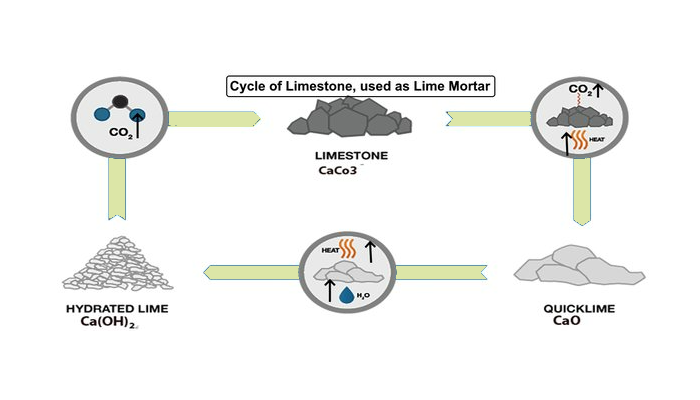What is Lime Mortar? Definition, Uses, Advantages
By BYJU'S Exam Prep
Updated on: September 25th, 2023

In Civil Engineering construction works, many concrete structures are designed. Mostly, In concrete structures, cement is added as the binding material. For other types of use, like plastering or finishing works, mortar can be used as the binding material. These mortars can be of many kinds, like lime mortar, cement mortar, and surkhi mortar. Only lime mortars were used earlier, but other types of mortar are used nowadays.
Lime Mortar consists of sand, lime and water. Sand and water are the common ingredients used to make mortar. Lime is added to make lime mortar, and cement is added to make the cement mortar. In this article, lime mortar is described in various aspects.
Table of content
What is Lime Mortar?
Lime mortar is a type of mortar made by mixing lime, sand and water. Hydraulic lime or fat lime (quick or hydrated lime) can be used as lime in lime mortar. Fat lime has high calcium oxide content. Its hardening depends on water loss, atmospheric carbon dioxide absorption, and possible recrystallisation. Small quantities of silica, iron oxide and alumina are present in the hydraulic lime. The mixture of hydraulic lime with water forms putty that has the property to set even within the water. Lime Mortar is an essential part of the GATE CE syllabus. Slacked fat lime is mixed with other ingredients for plastering work to make the mortar. In contrast, hydraulic lime is used for masonry construction and is most suitable for constructing chimneys and lightly loaded superstructures.
Properties of lime mortars include plasticity, placability, good cohesion with other surfacings materials, and little shrinkage. They harden and develop very slowly, continuously gaining strength over a long period. Mortars of fat lime do not set but can stiffen only as water is lost by absorption and evaporation processes. The gain in strength is a very slow reaction of lime with carbon dioxide absorbed from the air.
What is Lime Cement Mortar?
Mortar is a mixture of sand, water and some other binding material. These binding materials may be lime and cement etc. Based on these ingredients, mortar can be classified into various types. It is called cement mortar if the cement has been added to the mortar. Lime cement mortar is used for formulating the GATE question paper. And if lime or surkhi is added, they are called lime mortar or surkhi mortar, respectively.
If lime in cement is added to make the mortar, it is known as lime cement mortar. It has some different properties than the other types of mortar. These properties enhance the overall strength of the mortar and provide better strength to the construction. Sometimes, surkhi is added to lime mortar to improve its strength and durability. Surkhi mortar is made from a mixture of lime, water and surkhi. Surkhi is a material that is made from burnt clay. It is mixed in lime mortar in its powdered form.
Lime Mortar vs Cement Mortar
Lime and cement mortar is used as binding materials for different construction works based on their advantages and suitability. The comparison of lime mortar vs cement mortar is important from the GATE exam perspective.
Here few comparative points are given concerning the cement and lime mortar.
- Lime mortar is generally made with lime, sand and water material, while cement mortar is a mixture of cement, sand and water.
- Cement mortar is a less porous material than lime mortar.
- Lime mortar has better strength than cement mortar.
Lime Mortar Advantages and Disadvantages
As we know, lime mortar is a mixture of lime, sand and water. It is used in construction due to its advantages and disadvantages. Here some points related to the advantages and disadvantages of lime mortar are mentioned below.
Advantages of Lime Mortar
- Lime mortar has good workability and water retention properties.
- It can reduce the potential for water percolation.
- It tends to reduce normal movement like thermal expansion etc.
- It can reduce the frost action.
Disadvantages of Lime Mortar
- Lime mortar sets rapidly. So reducing the user’s time for gauging.
- It may contain some soluble salts that can cause salt damage to brickwork or stonework.
- Segregation of cement can occur after the drying of works.
Use of Lime Mortar
Lime mortar is a building material consisting of lime, sand and water. It can be used for repairing old buildings and for restoration. In the lime mortar, lime and sand are mixed together in the proportion of 1:3. Setting of lime mortar occurs by the process of carbonation.
Lime mortar is mostly preferred over straight concrete because of its better properties. The quality of lime mortar help structures withstands the weathering effect and better controls ageing. An ordinary concrete mortar used between the brickwork or stonework may cause a cracking effect.

For more understanding about the lime mortar and other building materials along with their properties, refer to the following video on Byju Exam Prep’s official youtube channel.



